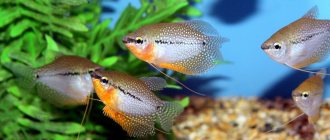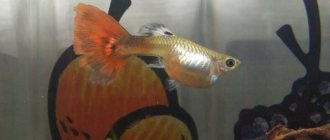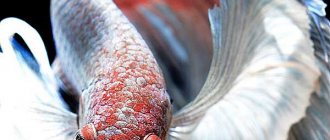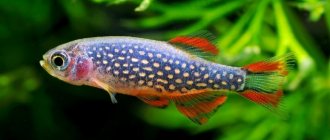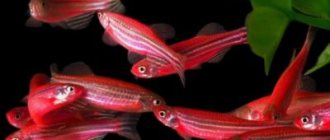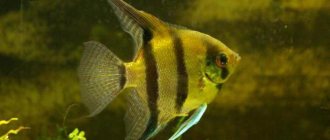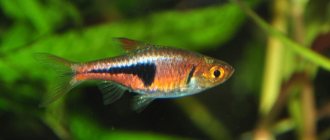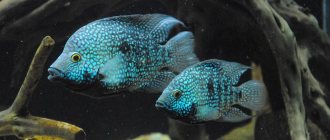29 December 19430aquarium fishtelescope
The telescope fish or goggle-eyed goldfish is one of the most popular types of ornamental aquarium fish. The main distinguishing feature of these fish is their huge bulging eyes. The aquarium telescope fish is widespread throughout the world. In this article you will find information about keeping the telescope fish and learn a lot of interesting things about it.
Motherland
China is considered the homeland. The telescope fish is not found in the wild. Back in 1500, thanks to long stages of selection, it was first obtained from wild crucian carp. The Chinese then gave it the name Dragon Eye, but the fish does not have a Latin name. The ancestors of the artificially bred telescope inhabit stagnant bodies of water. They feed on fry, small insects and plants.
In 1872, several specimens of the telescope fish were brought to Europe. They were acquired by aquarist Pierre Carbonnier. In the same year, he gave two females to the Russian aquarist Meshchersky.
The body is short, egg-shaped. A chic, fluffy tail resembles the shape of a skirt or butterfly. The eyes are bulging, they see poorly in the dark. The diameter of each visual organ can reach up to 5 cm. The dorsal fin is large, equal in size to the body. There are many color variations of the big-eyed telescope fish.
Fish telescope - has a large number of color variations!
There is a type of telescope that has Chinese characters on its body!
Varieties
The black telescope is classified according to several criteria:
- size and type of fins;
- eye shape;
- scale color.
All fish of this breed have a barrel-shaped body, and the fins are very delicate to the touch. The tail has a forked tip and reaches 3 cm in length. Based on the type of eyes, telescope goldfish are divided into:
- cone-shaped;
- cylindrical;
- rounded;
- with twisted eye sockets;
- with overlapping caps.
There are the following color options for aquarium pets with big eyes:
- dark bronze (typical of young individuals);
- red and silver (found among some adult aquarium inhabitants);
- coal-black (the color is not constant; when the conditions of detention change, it changes to the light side);
- velvety black (this type of telescope looks the most elegant; each individual is valued depending on the uniform distribution of the pigment coloring the scales).
When purchasing a black goldfish, you need to remember that the color of the body appears over time. At the time of purchase, it is difficult to guess what the inhabitants of the aquarium will look like in a few months. The black telescope is classified according to the shape and size of the fins:
- short-finned breeds (nowadays they are extremely rare, but were widespread during the birth of the exotic variety of aquarium pets);
- skirt breeds (these fish got their name because of their fins - long, hanging from the sides of the body);
- ribbon fish (compared to other fish, they have an elongated body and a long dorsal fin that runs through the entire body; there is no rear fin).
Due to its structural features, the ribbon variety is characterized by its inability to make rapid movements. The fish often loses its balance and rolls over. This is especially noticeable after eating a large amount of food and when the fins are weakened.
Care and maintenance
To keep a water dragon you need a spacious rectangular aquarium. A round aquarium, due to improper refraction of light, will worsen the already poor vision of the fish and lead to blindness. Fish have a good appetite, so due to the large amount of waste, a powerful external filter will be needed. To saturate the water with oxygen, you should install a compressor in the aquarium.
Water parameters per individual:
| Volume | Temperature, C° | Acidity, pH | Hardness, рGH |
| 50 liters | 17-23 | 6,5-8 | 6-18 |
It is important to ensure safety and comfortable conditions for aquatic inhabitants. Pebbles or coarse sand are placed on the bottom. Often individuals, rummaging in the sand, swallow its particles. The small ones are spit out, and the large ones are choked. Help from the aquarist must occur immediately, otherwise the fish will suffocate.
Laconic design is what you need for telescopes! The fewer decorative items, the safer!
For decoration you need to choose smooth rocks and grottoes without sharp edges. This reduces the likelihood of damage to bulging eyes.
Every week the water is changed by 20%. Proper maintenance conditions significantly extend the life of a water dragon.
Since fish are active diggers in search of food, it is better not to plant living plants, as very soon they will not have roots.
Use heaters to heat water. Sudden temperature fluctuations can be detrimental to telescopes.
You can feed all types of live and dry food. Excluding their combination in one feeding.
Introduction
It is recommended for the beginning aquarist to keep Fantail, Ryukin (or Nymph) and Black Telescope, but the latter should not be housed with fish competing for food. These three varieties, as well as the Common goldfish, Comet and Shubunkin, are easy to keep. This is due to the ability to withstand temperatures just above zero, when it drops by several degrees per day.
For most of these variations, their hardiness makes them ideal residents of a backyard pond. The only exception is the Black Telescope. This is not due to a lack of stamina, but due to his telescopic eyes. Because of them, the fish have poor eyesight, which is extremely bad when competing for food; in addition, they are easy to injure and become infected. It is worth noting that none of the above-mentioned goldfish species are suitable for cohabitation with the Black Telescope. They are too strong competitors for food. Acceptable neighbors include Telescope, Stargazer (Skyeye), and Bubbleeye (Watereye), which are less hardy but have similar limitations.
On the left is Bubble Eye (“Water Eyes”) (photo: bluexocean.blogspot.com/2011/07/gold-fish.html), on the right is Stargazer (“Heavenly Eye”).
Modern goldfish are descendants of wild cyprinids, such as the silver crucian carp, or Carassius auratus gibelio, described by Bloch in 1782. These cyprinids originate in Asia, Central Asia (Siberia). They live in slow-flowing and stagnant waters of rivers, lakes, and ponds, feeding on plants, small crustaceans and insects. For a long time it was believed that goldfish descended from the Golden crucian carp, or Carassius auratus auratus, described by Linnaeus in 1758, but recent research points to the previous version.
Goldfish were originally developed in China, but by 1500 they were sold to Japan, by 1600 to Europe, and by 1800 to America. Most of the fancy goldfish were bred by oriental hobbyists. We can observe the results of centuries of painstaking work in the bizarre shapes and colors of modern goldfish. Currently, domesticated goldfish are distributed throughout the world.
The Black Telescope is a black variation of the Telescope, a goldfish believed to have originated in China in the early 18th century. Then this species was known as “Dragon Eye” or “Dragon Fish”. In the later half of the 18th century, they began to be bred in Japan, giving the name "Demakin". The black telescope is also often called the Dragon's Eye, the Black Peony, or the Black Demekin. This is one of more than 125 artificially bred variations of the fancy goldfish.
Compatibility
A fish with bulging eyes will not be able to get along with all the inhabitants of the aquarium. She is slow, gluttonous and vulnerable. It is strictly forbidden to keep her with aggressive and overly active roommates.
Bad proximity to the following fish:
- barbs;
- gourami;
- swordtails;
- cichlids;
- gourami;
- arowanas;
- Siamese cockerels;
- piranhas
Most of these cohabitants will injure the telescopes' eyes, scales and gnaw off their fins. Active fish will simply leave crucians with big eyes hungry.
Telescopes thrive in the company of their own kind. And the goggle-eyed flock looks great!
The ideal option is to keep them with related species or separate families. The best compatibility is considered to be cohabitation with goldfish, orandas, veiltails or shubunkins.
The history of the origin of the bug-eyed fish
Asian countries are considered the homeland of these unusual fish. They came to Europe relatively recently - at the end of the 19th century. There they quickly became popular as pets. Several individuals were brought to Russia, where domestic breeders created by crossing a completely new species - a fish with large beady eyes, which is now popular all over the world. The classic breed of such “telescopes” is considered to be black, but there are also a number of breeds that were irretrievably lost:
- pure white fish;
- white and red veil fish;
- colorful fish without scales with veil or regular fins.
Veil fins look like long, thin and delicate transparent fabrics that flutter smoothly when moving in the water.
The classic breed of such “telescopes” is considered to be black.
Diseases
If you care for aquarium animals incorrectly, this will sooner or later lead to the development of diseases. Most often, diseases begin due to overfeeding, sudden temperature changes, poor filtration and aeration. Elimination of the cause must begin immediately with the first symptoms, otherwise the aquatic inhabitant will die.
Diseases and symptoms:
Mouth rot
A contagious bacterial disease. The main sign of the disease is a white coating around the mouth. The fish may die after 3 days. Treated with antibiotics.
Carp pox
The herpes virus causes the development of the disease. Occurs if the aquarist does not follow the rules for caring for the aquarium. Pink or white growths form on the head, body and fins. The infection is incurable.
Inflammation of the swim bladder
The fish turn over with their belly up, lie on the bottom or hang near the surface of the water.
Eye diseases
The main cause is dirty water or eye injuries. The fish develop a white coating on their eyes. Treatment consists of eliminating the causes.
Helminthiasis
Parasitic worms enter the body with food or dirty water. The fish become passive, eat poorly, and then completely refuse food. As soon as symptoms are detected, the sick fish should be placed separately and, in addition to direct treatment, the general aquarium should be treated for preventive purposes.
Reproduction
You should start breeding telescopes only after the individuals are 2 years old. It is very difficult to distinguish a female from a male, since sexual dimorphism is poorly developed . The easiest way to do this is during the spawning period, this is how experienced aquarists understand that it’s time to remove the individuals. In males, white tubercles can be seen on the gills, and in females, the abdomen enlarges and becomes rounded.
A pair of telescopes can only be determined during the period of courtship or with extensive experience.
Reproduction usually occurs in the spring, so you need to prepare a 30-liter tank in advance. It will be needed for spawning, and then for the growth of young animals.
Recommended parameters in the tank:
- acidity – 6-7 pH;
- temperature – 25C°;
- hardness – 9-10 rGH.
Java moss or algae should be placed on the bottom for egg laying. For reproduction, taking into account sexual dimorphism, a pair of healthy individuals who have reached the age of two are selected. They are released into the tank in the evening, first the female, and a couple of hours later the male. Reproduction usually begins the next morning.
During one spawning, the female lays up to 2000 eggs. Adults must be immediately placed in a common aquarium, otherwise they can completely destroy the young.
The grown-up fry of the telescope do not yet have an outstanding appearance.
After 96 hours, the first fry hatch. After 4 days they begin to move and need to be fed small dry food. As soon as their length reaches 5 cm, they can be introduced into a community aquarium.
Popular types
Thanks to the painstaking work of breeders, several varieties of telescopes were developed, which differ from each other in: scales, color, fins, degree and shape of bulging eyes. Despite the fact that there are quite a lot of types of telescopes, they all have one similarity - these are large bulging eyes on the sides of the head.
The most popular representatives are:
gold fish
The body has an orange color and a metallic sheen;
Panda
On the body the pattern alternates with black and white velvety stripes and has a scaleless body;
Black Moor
It has a rich charcoal color, the tail is small, the remaining fins are also small and neat;
Calico butterfly
A beautiful and unpretentious fish, it has a luxurious tail, shaped like the wings of a butterfly, its color can be gold, black and white.
What does a telescope look like?
The telescope goldfish is an egg-shaped fish. It has the following differences:
- short rounded body;
- the presence of round, strongly protruding eyes located on the sides of the head;
- velvety black color of the scales, a metallic tint appears in the light;
- large size of fins fluttering when moving;
- the possibility of acquiring copper-colored scales when kept at high temperatures;
- quite large in size (the length of the average telescope fish reaches 10 cm, there are individuals that grow up to 25 cm).
Baby goggle-eyed goldfish do not have bulging eyes. The scales are dark bronze in color. With age, the appearance of the head and the color of the body change. Previously, there was such a variety of fish as the veiltail, which had a beautiful caudal fin. Modern pets have a straight or ribbon tail.
Reviews
Our family has had an aquarium for about 6 years. During this time, the inhabitants changed a couple of times, but the bug-eyed telescopes are always there. I especially like the Black Moor. Its rich charcoal color makes it stand out from the rest of the population. I feed him 2 times a day, and 2-3 times a month I definitely pamper him with live food. Elena, 32 years old
There are 4 telescopes in my aquarium. This is an unpretentious fish, but it must have an aerator and filter. They are very interesting to watch. In addition to the fact that the fish have an attractive appearance, they constantly dig in the sand in search of food, although when they find it, they may not even eat it. This is their meaning of life. This spring I want to try to carry out the breeding process. Alexander, 46 years old
Feeding
Feeding is not difficult, they eat all types of live, frozen and artificial food. The basis of their feeding can be made of artificial food, for example, granules.
In addition, you can give bloodworms, brine shrimp, daphnia, and tubifex. It is necessary to take into account that telescopes have poor vision, and they need time to find food and eat.
At the same time, they most often dig into the ground, raising dirt and turbidity. So artificial feed will be optimal, they do not get buried and slowly disintegrate.

